Premier Amplifiers
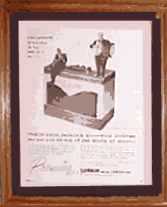 With
their multi-color knobs and their two-tone bodies, Premier amps have style.
They were the music store "house brand" in the 50's and 60's, the
brand that you bought if you couldn't afford the Fender. Most of the amps that
I've seen have been small to midsize, low on power, yet long on tone. My best
harp amp is a Premier amp. These are collectable to those of us who can't spend
thousands on a tweed Fender, but we can afford the same year (and the same circuit)
in a Premier amp for under $100. The guitar players avoid them because they
don't have the same mystique as a Fender and most Premiers are lower power and
guitar players want power.
With
their multi-color knobs and their two-tone bodies, Premier amps have style.
They were the music store "house brand" in the 50's and 60's, the
brand that you bought if you couldn't afford the Fender. Most of the amps that
I've seen have been small to midsize, low on power, yet long on tone. My best
harp amp is a Premier amp. These are collectable to those of us who can't spend
thousands on a tweed Fender, but we can afford the same year (and the same circuit)
in a Premier amp for under $100. The guitar players avoid them because they
don't have the same mystique as a Fender and most Premiers are lower power and
guitar players want power.
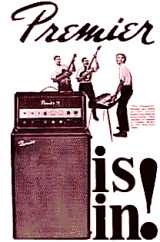 If
you have an old Premier amp or reverb unit, send me a picture or two as well
as any information on how it plays, where you got it, what tubes it uses, etc.
If
you have an old Premier amp or reverb unit, send me a picture or two as well
as any information on how it plays, where you got it, what tubes it uses, etc.
I restore old Premier amps (for my own collection only). If you have or know someone who has a basket case Premier, I'm buying. I'm not interested in buying working amps in good condition - there's no fun in it.
Here is a great 1962 Amp Premier Catalog. Thanks to Rober Davis for sharing!
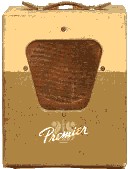 Click on picture to see gallery |
Model 50. The 50 has an 8" speaker and may be the earliest of the Premier production models that I've seen. I have seen component dates (off the pots or speaker) of 1947. The Model 50 changed shapes from 1947 up to the mid 60s. The configuration shown at left was sometimes rotated 180°. Later the cabinet changed to a more standard (and boring design). I have counted, so far, 6 tube layouts. The 50 circuits are almost identical to Fender Champs of the same era. I have an abused 1957 model 50 that is my favorite harp amp. |
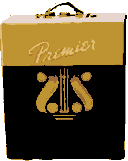 Click on picture to see gallery |
Model 110 and 120. These amps had an "overbite". The top was wider than the bottom. The speaker part was under a shelf. The 110 had a 10" speaker and I think that the 120 had a "12 inch speaker. They were larger speaker versions of the 50, but didn't have much more power. The amps evolved over the years just as the 50. I have seen only one of these in person. The images that I have are all stolen from around the Web. |
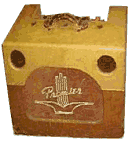 Click on picture to see gallery |
Model 71 and 75. Think of a Fender Bassman with Tremelo and you have a 71. It has a HUGE transformer driving 2-6L6's with a 5U4 rectifier. It has a 12" speaker and two small 3 inch special Jensen's in case there's something that the big Jensen missed. All the power a harp play could ask for and my guitar friends love it's velvet like tone and great tube crunch. It's too good for a guitar. The 75 is a head that I guess was meant to compete with the Fnder heads in the 1960's. |
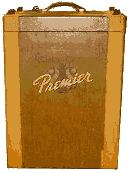 Click on picture to see gallery |
Suitecase Models - 76 and 88. Premier made special amps that folded up like a travel wardrobe. These are very cool looking. The 88 has a set of very cool colored keys with preset tone controls. This allows you to change to a setting by pressing a combination of keys. I found a 76 cabinet without an amp and I'm looking for an amp chassis to put inside it. |
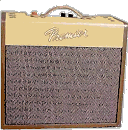 Click on picture to see gallery |
Model 60 and 160 "Club Bass". These are Premier's Bass amps designed for a small club venue. They are not like the Fender Bassman, but have ciruits similar to the Tweed Deluxe - 2 6V6 power tubes. They have a 12" speaker. The preamp circuits seem to be "tuned" for a bass guitar, and are not overly loud for harp or guitar. They have a sweet, mellow tone that is easy to overdrive and are good for harp if you mic them. I also included a picture of a B-220 here |
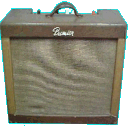 Click on picture to see gallery |
The Twins - T12R and Twin 8. The twin amps are not as powerful as the Fender Twins of the same era. They get a nice fat tone by using 2-6V6's like the Fender Tweed Deluxe or a 7591 Power tube in the case of the Twin 8. The 1960's Premiers often have the 7591 tube and it seems to have more power then the previous configurations but in a smaller package. My 1961 model 50 has one and sounds great! |
 Click on picture to see gallery |
Reverb units Model 90. In the Amp Mythos it is said that Linc Ray, used Premier Amps and used the model 90 reverb unit. When Leo Fender wanted to make an amp for Ray, he put a Hammond organ reverb tank in the bottom of a Fender Super and Ray switched to the new Super Reverb amp. If Premiers had combined reverb with their amps all you guitar players would be using Premier amps and this would be a Fender page. |
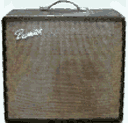 Click on picture to see gallery |
Later Models. Multivox produced amps throught the 60's and 70's. They followed the trends and switched to transistors and to compete with the far east, dropped many of the cool features that made Premiers unique and even lost the colored knobs. The amps, for what they were, kept up a tradition of quality. The transistor bass amps have a following, still. |
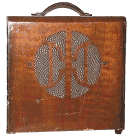 Click on picture to see gallery |
One of a kind and odd models. Premier amps are often repackaged in a different cabinet or modified and some are just not identifiable. I've collected a couple of amps that claim premier parantage, but who knows? |
 Click on picture to see gallery |
Schematics. I have a few schematics, mostly hand drawn. If you have a copy of a premier schemtic or know where I can get a service manual, please lend it to me so I can scan it. |
I have an old address for Multivox. If you have any information about the company please let me know. They sold Keyboards and Synthesizers and a line of guitar effects up to the early 1990s and then dissappeared.
Elepian-Multivox
370 Motor Parkway
Hauppauge, NY, 11787
The Japanese solid state amps might also have been made under the Premier name by
HILLWOOD ELECTRONICS MUSICAL INSTRUMENT CORPORATION
